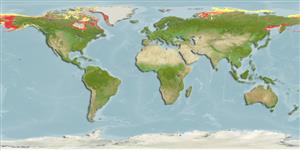Environment: milieu / climate zone / depth range / distribution range
Ecologia
marino demersale; distribuzione batimetrica 0 - 94 m (Ref. 50550), usually 30 - 46 m (Ref. 48978). Polar; 83°N - 40°N, 136°E - 42°W
Western Atlantic: Arctic Ocean to southern Labrador, Canada and western Greenland. North Pacific: Japan (Ref. 559) and Alaska (Ref. 11366).
Size / Peso / Age
Maturity: Lm ? range ? - ? cm
Max length : 30.0 cm TL maschio/sesso non determinato; (Ref. 7251)
Short description
Chiavi di identificazione | Morfologia | Morfometria
Spine dorsali (totale) : 80 - 83; Spine anali: 2; Raggi anali molli: 38 - 42; Vertebre: 87 - 90.
Facultative air-breathing (Ref. 126274); Entirely subtidal (Ref. 48978). Benthic; feeds on crustaceans and worms (Ref. 58426).
Life cycle and mating behavior
Maturities | Riproduzione | Spawnings | Egg(s) | Fecundities | Larve
Robins, C.R. and G.C. Ray, 1986. A field guide to Atlantic coast fishes of North America. Houghton Mifflin Company, Boston, U.S.A. 354 p. (Ref. 7251)
IUCN Red List Status (Ref. 130435)
Threat to humans
Harmless
Human uses
Strumenti
Special reports
Download XML
Fonti Internet
Estimates based on models
Preferred temperature (Ref.
123201): -1.4 - 2.8, mean 0 °C (based on 367 cells).
Phylogenetic diversity index (Ref.
82804): PD
50 = 0.5005 [Uniqueness, from 0.5 = low to 2.0 = high].
Bayesian length-weight: a=0.00162 (0.00068 - 0.00388), b=3.19 (2.99 - 3.39), in cm total length, based on LWR estimates for this (Sub)family-body shape (Ref.
93245).
Trophic level (Ref.
69278): 3.3 ±0.39 se; based on food items.
Resilienza (Ref.
120179): Medio, tempo minimo di raddoppiamento della popolazione 1.4 - 4.4 anni (Preliminary K or Fecundity.).
Fishing Vulnerability (Ref.
59153): Low vulnerability (20 of 100).
